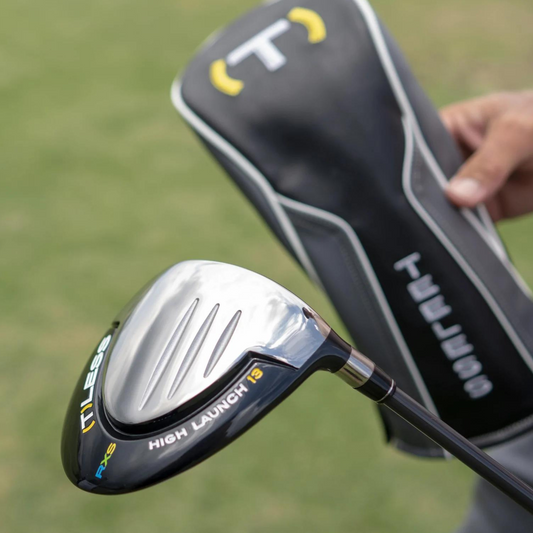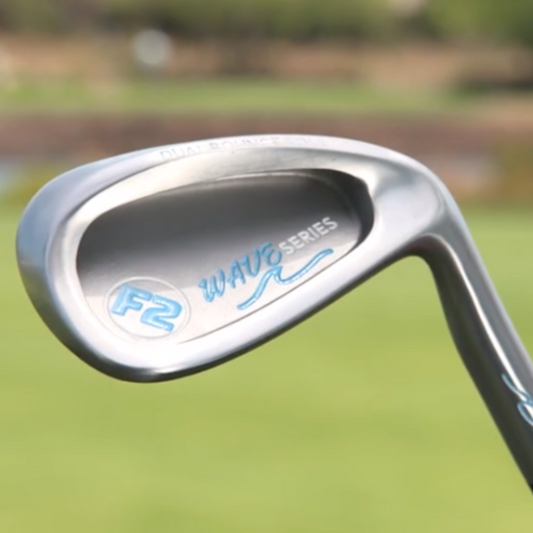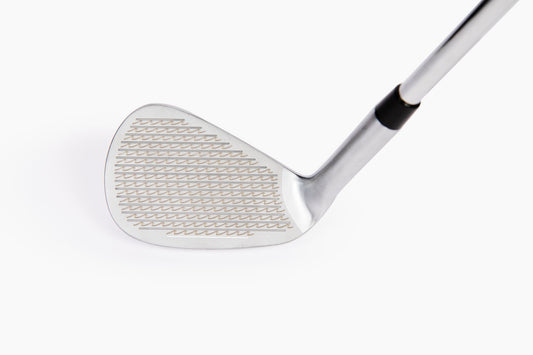
Learn How to Stop the Shanking the Golf Ball Once and For All
Tired of sending your golf balls on unexpected detours to the right (or left)?
You're in the right place.
In this ultimate guide on how to stop shanking, we'll go over the causes of shanks, top four tips to stop shanking the golf ball, the best drill to stop the shanks along with a few other shank golf drills, the best "shank-proof" wedge out there, and end with some FAQs.
Whether you're a seasoned pro or just starting out, we've got the advice you need to keep your shots out on the golf course and your game on par.
Say goodbye to shanks and hello to straight shots with these expert tips and techniques only at GoGolf365.
Topics Covered in This Guide

What is a Shank?
A golf shank occurs when the golf club hits the golf ball in such a way that causes it to veer sharply to the right (for a right-handed golfer) or left (for a left-handed golfer). The shot typically flies low and to the right of the target, and is often described as "squirting" off the clubface.
What Causes Shanking
Before we learn how to stop shanking, we have to take a look at what causes you to shank the golf ball.
Striking the Hosel
First, it's important to understand where the ball makes contact when a shank occurs, and making contact with the hosel is usually the culprit.
The hosel is where the shaft connects to the club head, and striking this area is one of the main causes of shanking the golf ball.

Poor Swing Mechanics
If you're not swinging the golf club correctly, you're more likely to hit the golf ball with the heel of the golf club, causing a shank. This can be caused by a variety of issues, including a too steep or too shallow swing path, incorrect grip, or incorrect weight distribution.
Lack of Focus
A shank can also be caused by a lack of focus or concentration. If you're not fully focused on the shot, you may hit the golf ball with the wrong part of the golf club like the hosel.
Club Design
Some clubs are more prone to shank than others. For example, clubs with a shorter hosel can be more difficult to hit cleanly, and can lead to a shank.
The easy fix to this is to play with a wedge that moves the hosel so it has extra hitting area in the heel; something like the F2 Wedge.
Swing Speed
Hitting a shank can be more common when swinging at higher speeds. This is because a faster swing can cause the golf club to move slightly away from the body, making it more likely to hit the golf ball with the heel of the golf club.
Improper Setup
Setting up incorrectly for the shot can also lead to a shank. For example, standing too close to the ball can cause you to hit it with the heel of the golf club, while standing too far away can cause you to hit it with the toe of the golf club.
Physical Limitations
Certain physical limitations, such as poor balance or flexibility, can make it more difficult to make a proper swing, and can lead to hitting a shank.
Pro-Tip: Learn how to improve your balance and flexibility with our vast library of Golf Fitness Videos lead by Lauren McMillin, one of the best instructors for golf fitness out there.

4 Tips to on How to Stop Shanking
Light Grip
Make sure you have a proper grip on the club, with your hands placed on the grip in the correct position. This can help you maintain control of the club face and hit the golf ball with the center of the clubface.
First, position your lead hand so that the grip runs diagonally across the fingers, with the thumb resting on top of the grip.
Then, position your trail hand so that the grip runs diagonally across the fingers, with the pinky finger resting on top of your index finger of your lead hand.
Don't have a tight death grip as it can lead to tension in the arm and hands, and don't grip too loose as it can cause the club face to twist at impact. You'll get a feel for it through practice.
Make sure your hands are positioned in a way that promotes control of the club face.
Finally, check to make sure your wrists are not too bowed or too cupped at address as this can cause the cub face to be open or closed at impact, leading to shanks.
Maintain Your Posture
Make sure you're maintaining your posture throughout the swing, and don't lean forward or backward. This can help you maintain control of the clubface and avoid hitting the golf ball with the heel of the golf club.
Adjust Your Weight Accordingly
Adjusting your body weight throughout the swing makes a huge difference.
At address, keep your weight evenly distributed in your feet.
At the top of the backswing, shift 60% of your weight to your front foot.
At impact, place most of your weight on the front foot.
Focus On Your Swing Path
Try to maintain a smooth, shallow swing path that approaches the golf ball from the inside. This can help you avoid hitting the ball with the heel of the golf club.

The Best Drill to Stop the Shanks
Learn how to stop shanking the golf ball with this great drill from GoGolf365 instructor John Novosel, Jr below. In this drill, John shows you the common mistake most golfers make that causes a shank and provides easy-to-follow tips and tricks that will help you improve your golf game and hit the ball more consistently.
Check out the video drill or read the transcript beneath it to get started.
Shank Drill Transcript
Hey golfers, John Novosel, Jr. here with GoGolf365 - I'm talking chipping and pitching. I'm gonna show you a common mistake that I see with golfers and what you can do to work on it. It's a subject that's very touchy. It's called the shanks.
I know that's scary to say that word. I hate saying it, but what I see a lot of with golfers, and the reason they do shank, is they get the golf club here and then for some reason, they go out this way with it.
So as you go this way, you just throw the hosel at the ball, and that's a big no no.
So we want to just be more on plane as opposed to helping it out this way away from the body.
What you see with a lot of really good golfers is on their follow through, their hands are in, they're never out.
So for your chipping technique, brush the grass, and then let that gently come around to your hip.
The other thing is, you'll notice I've got this really cool new wedge from F2. What you'll see on it is that it's got this leading edge way up in front of the hosel; it's shank proof. I absolutely love this.
When you set up to this, you're gonna make a swing, and even if you throw the hosel, it goes dead straight. It's got this extra room on the sole so you can hit it off of there, it's really gonna help - but anyway on to the tip.

No throwing out - let this be gentle, let your arms be soft back here. That's going to help you stop the shanks, and these F2 Wedges will also help as well.
Let that wedge come back around, don't go out with it.
Try that and leave your comments below. Thanks again for watching.
The Best Wedge to Stop Shanking
While this guide explaining how to stop shanking the golf ball is vital, your best bet to stop golf shanks once and for all is to make the instant fix of playing with a golf club that stops the shanks for you.
The best wedge to stop shanking the golf ball is the "shank-proof" F2 Wave Series Wedge from GoGolf365.
The hosel - where the shaft meets the club head and the cause of most shanks - is re-positioned so that you can't strike the ball with it.
This simple change takes shanks out of the equation completely and boost your confidence immediately - and over 160+ verified customer reviews back us up.
Add the F2 Wedge to your bag today to finally make shanks a thing of the past.
FAQs
How do you fix shanking?
To fix shanking in golf, try to focus on improving your swing mechanics, such as maintaining a smooth, shallow swing path that approaches the ball from the inside, keeping your weight forward, and maintaining your posture throughout the swing. It's also a good idea to not stand too close to the ball.
What is the main cause of a shank?
The main cause of a shank in golf is hitting the ball with the heel of the club instead of the center of the clubface. This can be caused by a variety of factors, including poor swing mechanics, lack of focus, improper golf club design, swing speed, improper setup, and physical limitations.
Why am I suddenly shanking the golf ball?
If you're suddenly shanking the golf ball, it may be due to changes in your swing mechanics, such as swing speed or setup. It could also be due to changes in your clubs, such as a change in golf club design or length. It's a good idea to review your swing mechanics and equipment to identify the cause of the shanking.
More Drills on How to Stop Shanking
There are several drills that can help you stop shanking in golf at the GoGolf365 Youtube channel. Here's our top recommendations.

Now you know the secrets of how to stop shanking in its tracks once and for all. By using these tips and techniques, you'll be hitting straighter shots in no time.
Remember to keep practicing, don't stand to close to the ball, make sure the ball makes contact with the center of the club, adjust your weight throughout the swing, and stay focused on your swing mechanics. Soon enough, you'll be saying goodbye to the shanks and hello perfect shots.
So the next time you're out on the golf course, don't forget to put these tips into action. Your scorecard will thank you.











